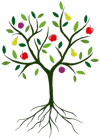King of the Pippins
King of the Pippins is a widely-grown apple from the Victorian period. It is very typical of the "reinette" style apple, with its flushed orange skin and firm rather than crisp flesh - quite different to the modern supermarket apple.
King of the Pippins is a versatile apple, which is probably the main reason for its success. Although usually considered a dessert variety, it can also be used for cooking - particularly French-style patisseries, since the slices keep their shape when cooked. It is a good juicing apple too, the juice has a good robust flavour and can also be used in cider blends.
King of the Pippins apple trees for sale
1-year bare-root
tree
on MM106 rootstock£34.95
Mature height: 3m-5m after 10 years
Can be trained on as a large free-standing apple tree, a half-standard apple tree, a large apple fan or espalier, or a pleached apple tree. Available next season
Growing and Training
King of the Pippins is a good and reliable cropper. It grows in a compact neat fashion. Disease resistance is fairly good.
Recommended pollinators for King of the Pippins apple trees
King of the Pippins is partially self-fertile, so you do not need another variety to pollinate it to produce fruit.
However you will get a better crop if you plant any of the following pollinator varieties nearby.
If you are not sure about pollination requirements don't hesitate to ask us.
Ellison's OrangeEllison's Orange is a well respected Cox-style apple which can achieve very good flavour.
GalaGala is popular supermarket apple - but better when home-grown, with a sweet pleasant flavour.
BraeburnBraeburn is one of the best-flavoured supermarket apple varieties.
Newton WonderA traditional English cooking apple, a good alternative to Bramley.
John DownieJohn Downie is a traditional crab apple for making crab apple jelly. White blossom and orange-red fruits.
Peasgood's NonsuchPeasgood Nonsuch is a highly-regarded old-fashioned English cooking apple.
Golden GemA traditional crab-apple featuring a mass of white blossom in spring, followed by yellow crab apples.
Golden HornetMalus Golden Hornet is a traditional white blossom crab apple, with persistent yellow fruits.
History
The origins of King of the Pippins are not certain, but it was first recorded around 1800 in London, where it was introduced by a nurseryman, Kirke of Brompton. It almost certainly comes from France where it is known as Reine des Reinettes, but there are many other synonyms for this variety.
King of the Pippins characteristics
- Gardening skillAverage
- Self-fertile?Partially self-fertile
- Pollinating othersAverage
- Pick seasonLate
- Picking periodearly October
- Keeping3 months or more
- Food usesEating freshCulinaryJuiceHard ciderDual purpose
- Country of originFrance
- Period of origin1800 - 1849
- Fruit colourOrange flush
You might also like these varieties
Claygate PearmainClaygate Pearmain is a popular English dessert apple of the Victorian era.
Orleans ReinetteOrleans Reinette is a traditional French apple variety, and remains popular for its old-fashioned flavour.
More about apple trees
Apples are very versatile, and all varieties can be eaten or used in the kitchen. However varieties specifically grown as eating apples tend to have the best flavours for eating raw.
The main thing to decide when choosing an eating apple is when you intend to eat the apples. Early season apples are typically ready in August, and generally don't keep very long. Mid-season apples are ripe in early September, while late-season apples start to become ripe in late September and October. Many of the late-season varieties can also be stored in a fridge or cold shed for several months into the winter.
Some apple varieties are self-fertile, but most are not. However in most areas of the UK you do not need to worry whether your apple trees are self-fertile or not, as there will be other apple trees in nearby gardens to help with pollination.
